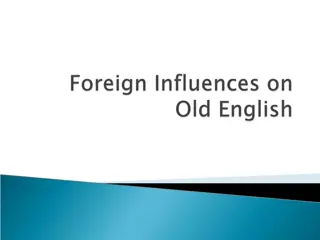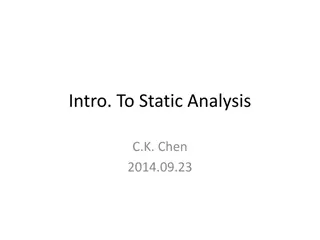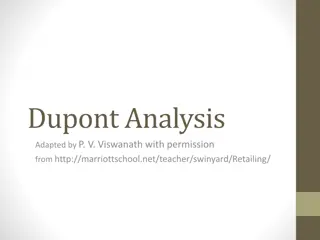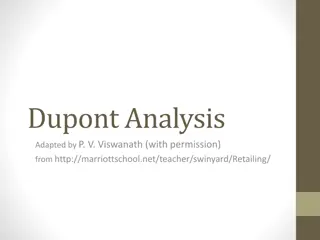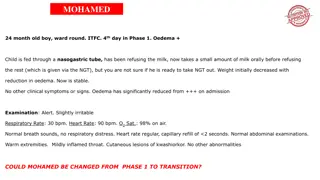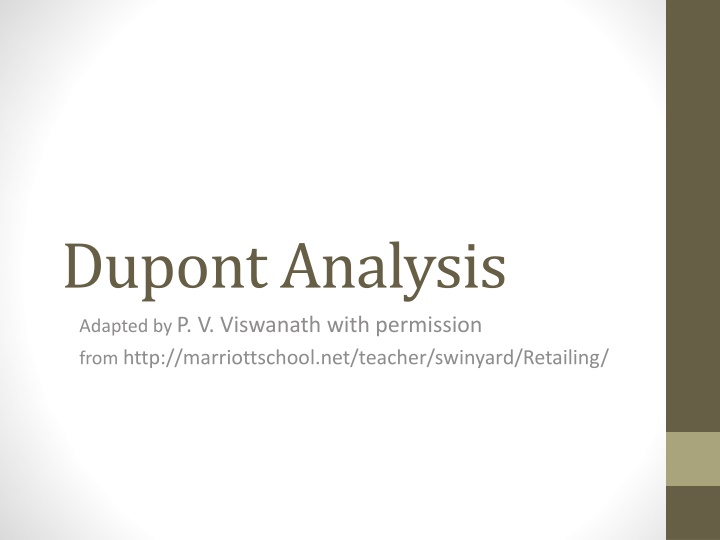
Analyzing DuPont Identity for Financial Insight
Gain insights into financial performance using DuPont analysis for ROA and ROE ratios, illustrated through examples from various industries. Explore strategies to enhance positioning in high turnover and margin segments. Compare net margins and ROA between Provo Bakery, Zales Jewelry, Tiffany, and Walmart. Dive into income statements of Walmart and Tiffany for a comparative analysis of net margins.
Download Presentation

Please find below an Image/Link to download the presentation.
The content on the website is provided AS IS for your information and personal use only. It may not be sold, licensed, or shared on other websites without obtaining consent from the author. If you encounter any issues during the download, it is possible that the publisher has removed the file from their server.
You are allowed to download the files provided on this website for personal or commercial use, subject to the condition that they are used lawfully. All files are the property of their respective owners.
The content on the website is provided AS IS for your information and personal use only. It may not be sold, licensed, or shared on other websites without obtaining consent from the author.
E N D
Presentation Transcript
Dupont Analysis Adapted by P. V. Viswanath with permission from http://marriottschool.net/teacher/swinyard/Retailing/
The Du Pont Identity ROA = NI/ TA ROA = (NI/ Sales)*(Sales / TA) ROA = (Net Profit Margin)*(Asset Turnover) ROE = NI / TE ROE = (NI/Sales)*(Sales/TA)*(TA/TE) = Net Profit Margin*Asset Turnover*Equity Multiplier Net Profit margin is a measure of the firm s operating efficiency how well it controls costs Total asset turnover is a measure of the firm s asset use efficiency how well it manages its assets Equity multiplier is a measure of the firm s financial leverage. Let s first look at the ROA identity a firm could have a high volume/low margin strategy, which would be reflected in high asset turnover but low profit margins or the reverse. P.V. Viswanath 2
ROA: Turnover vs Margin High Turnover Unattainable High Margin Low Margin Failure Low Turnover Two of the four segments might be unattainable or undesirable. But how should a manager improve the firm s positioning in the other two segments?
Illustrations of the Dupont Identity The Dupont identity is fairly well known as an accounting identity. Accountants use it as a model for managerial control and as a basis for firm valuation. However, it can also be the basis for alternative marketing strategies. Let us see how this works, as reflected in the practices of some US corporations. We first look at Provo Bakery and Zales Jewelry, two firms in two different industries.
Return on Assets Net Profit X Asset = Return on Margin Turnover Assets Provo Bakery 10% X 9 times = 90% Zales Jewelry 90% X 1 time = 90% Both firms have the same ROA, but different combinations of profit margin and asset turnover. Perhaps the different approaches simply reflects the difference in industries? Let s now look at two firms in the same industry: Tiffany, a jewelry retail firm and Walmart, which is another jewelry retail firm and, according to its website, the world s largest but quite different. (http://walmartstores.com/sustainability/9137.aspx)
Income Statements: Wal-Mart vs Tiffany (2000, in millions) Wal-Mart Tiffany Net sales $ 139,208 $ 1,173 Less: Cost of goods sold $ 108,725 $ 515 Gross margin $ 30,483 $ 658 Less: Operating expense $ 22,363 $ 493 Less: Interest expense $ 950 $ 9 Total expense $ 23,313 $ 502 Net profit, pretax $ 7,170 Less: Taxes* $ 2,740 $ 66 Tax rate 38.21% 42.31% Net profit after tax $ 4,430 $ 90 $ 156 * Effective tax rates often differ among corporations due to different tax breaks and advantages. Which has the higher net margin? Source: Levy & Weitz
Profit Margin Model: Wal-Mart vs Tiffany (2000, in millions) Net Sales $139,208 $1,173 Gross margin $30,493 (21.9%) $658 (56.1%) Top Number = Wal-Mart Bottom Number = Tiffany - Cost of goods sold $108,725 $515 Net profit before tax $7,170 $156 - Net profit after taxes $4,430 $90 Operating expenses $22,363 $493 - Net profit margin 3.18% 7.68% Total expenses $23,313 $502 Taxes $2,740 $66 + Interest expenses $950 $9 Net sales $139,208 $1,173
Profit Margins Clearly, Tiffany has the larger profit margin (gross margins 56.1% vs 21.9%; net margins 7.68% vs 3.18%)%. The model in the previous slide also shows exactly where the profit margin comes from. The focus in this approach is on the numerator of the profit margin ratio, viz. on Net Profit After Taxes (NPAT). It behooves the savvy manager to look at the components of NPAT as a fraction of sales. Is it possible to improve cost of goods sold and operating expenses as a fraction of sales but without affecting sales? How are these being used to improve sales?
Asset Turnover Model: Wal-Mart vs Tiffany (2000, in millions) Accounts receivable $1,118 $108 Top Number = Wal-Mart Bottom Number = Tiffany What does this represent? + Merchandise inventory $17,076 $481 From income statement Net sales $139,208 $1,173 Total current assets $21,123 $816 Asset turnover 2.78 1.11 + Cash $1,878 $189 Total assets $49,996 $1,057 + From balance sheet + The sales $ generated by each $ of assets Fixed assets $28,864 $241 Other current assets $1,059 $37
Asset Turnover Clearly, Walmart has the larger asset turnover. The model in the previous slide also shows exactly what is the source of the higher asset turnover. The focus in this approach is on the denominator of the asset turnover ratio, viz. on Total Assets. It behooves the savvy manager to look at the components of total assets in terms of how they contribute to sales. Is it possible to reduce accounts receivable and merchandise turnover and other assets but without affecting sales? How are these assets being used to improve sales?
Dupont Analysis: Wal-Mart vs Tiffany (2000, in millions) 2000 data Net Profit Margin Net Income/Net Sales Asset Turnover Net Sales/TA ROA Walmart 3.18 2.78 8.84 Tiffany s 7.68 1.11 8.525 Although Walmart and Tiffany clearly have different marketing/merchandising strategies, they end up with approximately the same ROA! In principle, this approach could be extended to look at ROE and include leverage choices as part of the mix. The next slide shows how different firms have made different choices in terms of net profit margin, asset turnover and leverage.
Financial Objectives: The Strategic Profit Model (SPM) Return on Investment Return on Assets Leverage Ratio x = Net Profit Net Worth Net Profit Total Assets Total Assets Net Worth Return on Assets Asset Turnover Net Profit Margin x = Net Profit Total Assets Net Sales Total Assets Net Profit Net Sales The $ sales generated by each $ of assets The net profit generated by each $ of sales and so ...
SPM Examples Return on Equity Investment Asset Turnover Net Profit Margin % Leverage Ratio = x x Big Lots: 24.6% 13.1 1.5 1.2 Albertson s: 18.9% 2.1 4.2 2.1 The Dress Barn: 32.4% 7.4 2.9 1.5 Land s End: 40.2% 6.8 3.1 1.9 The Limited: 32.3% 6.7 2.2 2.2 The Gap: 25.5% 6.6 2.4 1.6 1998 data
ROI Model, Including The Strategic Profit Model Which is the income statement? Balance sheet? SPM? Net Sales Net Sales Gross margin margin Gross Income Statement Balance Sheet Strategic Profit Model - Cost of goods sold goods sold Cost of - Net profit Net profit Variable expenses expenses Variable Net profit margin margin Net profit Total expenses expenses Total + Net Sales Net Sales Fixed expenses expenses Fixed Return on assets assets Return on x Inventory Inventory Return on Net Worth Net Worth Return on x = Net sales Net sales + Asset turnover turnover Asset Financial Leverage Leverage Financial Total current assets assets Total current Accounts receivable receivable Accounts Total assets assets Total + + Other current assets assets Fixed assets assets Other current Fixed
Retail Stratgies Look at some of these firms and figure out their strategy http://marriottschool.net/teacher/swinyard/Retailing/retail_links.htm As the previous slide points out, the two arms of the Dupont ROA identity could be thought of as reflecting alternatives focusing on the income statement (profit margin) versus on the balance sheet (volume). However, both approaches really reflect different uses of a company s assets/capabilities. The next two slides show how Walmart has worked on one aspect of its balance sheet, while the remaining slides look at how Tiffany s marketing focus on profit margin is reflected in its asset choices.
Walmarts focus on efficient asset use The use of information technology has been an essential part of Wal-Mart's growth. A decade ago Wal-Mart trailed K-Mart, which could negotiate lower wholesale prices due to its size. Part of Wal- Mart's strategy for catching up was a point-of-sale system, a computerized system that identifies each item sold, finds its price in a computerized database, creates an accurate sales receipt for the customer, and stores this item-by-item sales information for use in analyzing sales and reordering inventory. Aside from handling information efficiently, effective use of this information helps Wal- Mart avoid overstocking by learning what merchandise is selling slowly. Wal-Mart's inventory and distribution system is a world leader. Over one 5 year period, Wal-Mart invested over $600 million in information systems. http://www.prenhall.com/divisions/bp/app/alter/student/useful/ch1walmart.html
Walmarts focus on efficient asset use Wal-Mart uses telecommunications to link directly from its stores to its central computer system and from that system to its supplier's computers. This allows automatic reordering and better coordination. Knowing exactly what is selling well and coordinating closely with suppliers permits Wal-Mart to tie up less money in inventory than many of their competitors. At its computerized warehouses, many goods arrive and leave without ever sitting on a shelf. Only 10% of the floor space in Wal-Mart stores is used as an inventory area, compared to the 25% average for the industry. http://www.prenhall.com/divisions/bp/app/alter/student/useful/ch1walmart.html
Financial Information Tiffany Net Sales/Cash from Sales Net Sales/Net A/R Net Sales/Inventory Asset Turnover Net Income/Sales ROA ROE 2004 0.993 15.153 2.296 0.836 9.90% 9.01% 11.84% 2003 0.995 15.095 2.331 0.887 11.43% 9.87% 12.25% 2002 1.003 16.306 2.627 0.985 10.81% 10.64% 9.75% 2001 1.006 15.591 2.559 1.064 11.13% 9.87% 15.72% 2000 0.991 12.33 2.915 1.095 10.78% 9.01% 14.68% Whitehall Net Sales/Cash from Sales Net Sales/Net A/R Net Sales/Inventory Asset Turnover 2004 1.003 99.84 2.14 1.454 2003 1.001 252.54 1.99 1.404 2002 0.999 285.04 1.95 1.343 2001 0.995 210.39 1.73 1.252 2000 1 135.48 1.67 1.201 Zales Net Sales/Cash from Sales Net Sales/Net A/R Net Sales/Inventory Asset Turnover 2004 2003 2002 2001 2000 1 1 1 1 1 N/A 2.91 1.338 N/A 2.88 1.496 N/A 2.8 1.472 N/A 2.77 1.709 N/A 1.57 1.007 Do you see a difference in the strategies of the three firms? Tiffany, in particular, has a low asset turnover compared to Whitehall and Zales, particularly in the later years. Let s see why..
The Tiffany Approach In the following videos, consider Tiffany s and asset use and think of our previous discussion. http://www.youtube.com/watch?v=tbG0btCu1S4&f eature=related http://www.trendhunter.com/trends/tiffany-co-to- launch-70-new-stores Let s now look at how Tiffany s management considers the issue in its 10K report.
Tiffany Brand Strategy Tiffany focuses on the profit margin. To do this, it needs to spend more on certain assets than Walmart. The TIFFANY & CO. brand is the single most important asset of Tiffany. The strength of the Brand goes beyond trademark rights and is derived from consumer perceptions of the Brand. Management monitors the strength of the Brand through focus groups and survey research. Management believes that consumers associate the Brand with high-quality gemstone jewelry, particularly diamond jewelry; excellent customer service; an elegant store and online environment; upscale store locations; classic product positioning; distinctive and high-quality packaging materials (most significantly, the TIFFANY & CO. blue box); and sophisticated style and romance. Intangible Assets consist primarily of Product Rights and Trademarks (about $10m. in 2010)
Tiffany Brand Strategy Tiffany s business plan includes many expenses and strategies to maintain the strength of the Brand. Stores must be staffed with knowledgeable professionals to provide excellent service. Elegant store and online environments increase capital and maintenance costs. Display practices require sufficient store footprints and lease budgets to enable Tiffany to showcase fine jewelry in a retail setting consistent with the Brand s positioning. Stores in the best high street and luxury mall locations are more expensive and difficult to secure, but reinforce the Brand s luxury connotations through association with other luxury brands.
Tiffany Brand Strategy The classic positioning of Tiffany s product line supports the Brand, but limits the display space that can be afforded to fashion jewelry. Tiffany s packaging practices support consumer expectations with respect to the Brand and are more expensive. Some advertising is done primarily to reinforce the Brand s association with luxury, sophistication, style and romance, while other advertising is primarily intended to increase demand for particular products. Maintaining its position within the high-end of the jewelry market requires Tiffany to invest significantly in diamond and gemstone inventory and accept reduced overall gross margins; it also causes some consumers to view Tiffany as beyond their price range.
The Walmart Stores In the following videos, look at Walmart s asset use and think of our previous discussion. How does it differ from Tiffany? Walmart Stores http://www.youtube.com/watch?v=RJphoRD1w0I http://vimeo.com/11111204 http://projects.flowingdata.com/walmart/
Crafting strategy post Dupont Once we look at the firm s Dupont and other ratios (such as Sales/GSA Expense ratio), we might want to suggest that the firm move in the direction of increasing profit margin or in the direction of increasing volume. This decision has to be taken, keeping in mind the capabilities and resources that the firm possesses. It is also necessary to look at the competitive environment. If there are many competing brands, then it might not be a valuable strategy to create a new brand, ab initio, in the same space. All the other Porter framework forces have to be considered. If the decision is to move in the direction of higher profit margin, then the firm has to think of a better brand. It might want to look at the ratio of Sales to advertising expenses. It might want to increase trade promotion efforts, as well. If it pursues the goal of higher volume, then a lower price and all that it entails is indicated. However, this may be achieved through different strategies, e.g. coupons or other off-price methods. Better credit terms may also be an option.







